Bar Charts
Bar charts are useful for comparing values across categories. You can also create grouped or stacked bars to compare multiple categories, and apply styles and customizations like colors, patterns, and text labels.
Writing prompts for Plotly Studio
You can create charts in Plotly Studio using natural language in different ways:
Ask a question - great for exploring your data:
Which factory produces the heaviest products?
Use a quick one-line prompt - concise and conversational:
Compare average weight by factory
Write structured detailed prompts - precise control and consistency:
Average Weight by Factory
Chart:
- Type: bar
- X: Factory location
- Y: Average weight
Data:
- Aggregation: average of weight by Factory location
Structured detailed prompts give you more control over chart type, data mappings, aggregations, and styling. Most examples on this page use this format.
Basic bar example
Example of comparing counts across categories.
<Chart Title>
Chart:
- Type: bar
- X: <category_variable>
- Y: <numeric_variable>
The following example uses this prompt structure with the factory_location variable from the built-in Plotly Studio dataset:
Total Products by Factory Location
Chart:
- Type: bar
- X: Factory location
- Y: Count of products
Data:
- Aggregation: count by Factory location
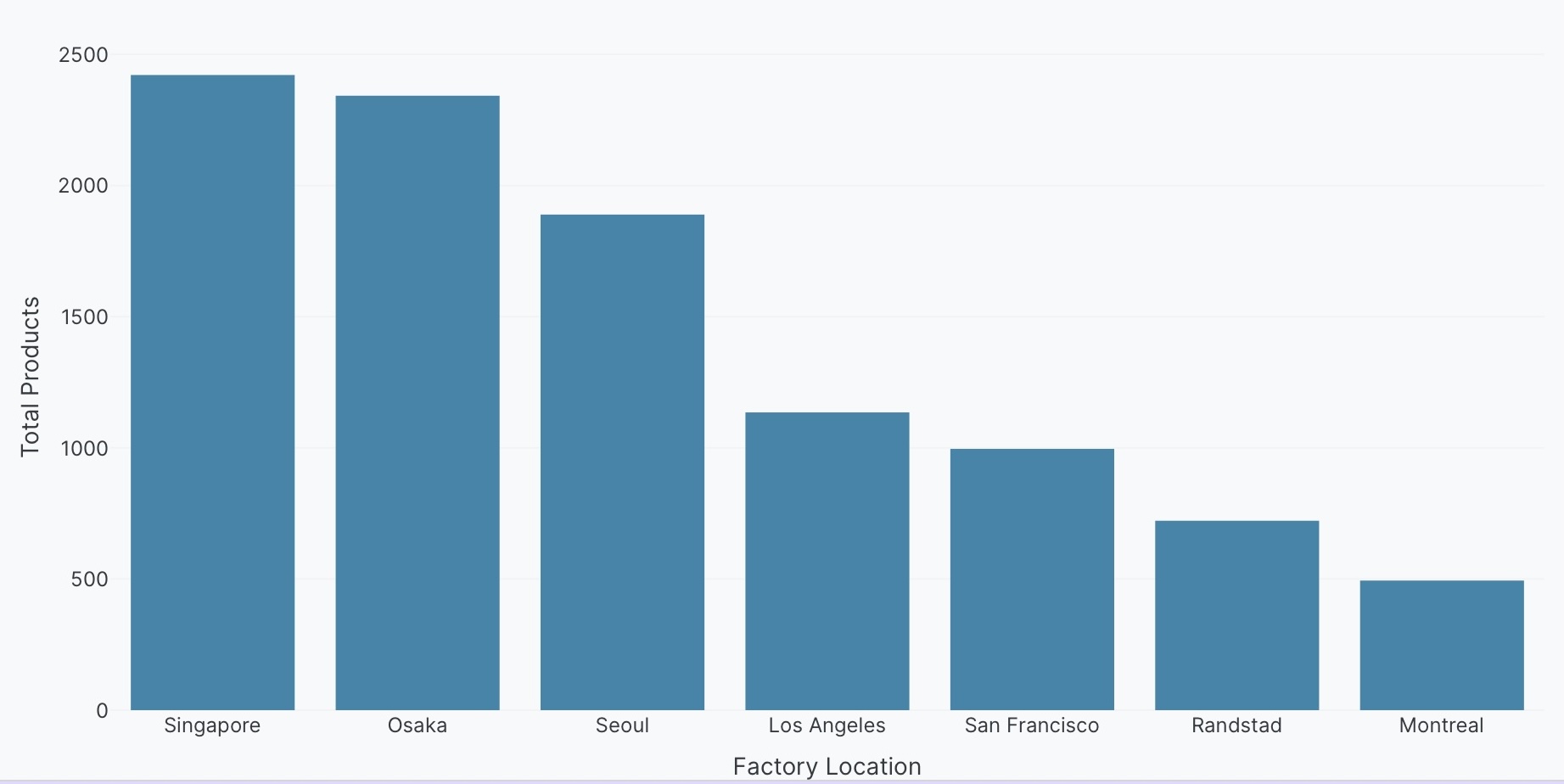
Horizontal bar charts
Create horizontal bars by setting the orientation.
<Chart Title>
Chart:
- Type: bar
- X: <category_variable>
- Y: <numeric_variable>
Chart styles:
- Make the chart horizontal
The following example uses this prompt structure with the factory_location variable from the built-in Plotly Studio dataset:
Total Products by Factory Location
Chart:
- Type: bar
- X: Factory location
- Y: Count of products
Data:
- Aggregation: count by Factory location
Chart styles:
- Make the chart horizontal

Grouped bar charts (side-by-side)
Create bars side-by-side to directly compare values between groups for each category.
<Chart Title>
Chart:
- Type: bar
- X: <category_variable>
- Y: <numeric_variable>
- Color: <second_category>
Chart styles:
- Use grouped bars
The following example uses this prompt structure with the factory_location and delivery_location variables from the built-in Plotly Studio dataset to compare delivery destinations side-by-side:
Total Products by Factory and Delivery Location
Chart:
- Type: bar
- X: Factory location
- Y: Count of products
- Color: Delivery location
Data:
- Aggregation: count by Factory location and Delivery location
Chart styles:
- Use grouped bars

Stacked bar charts (bars on top of each other)
Stack bars on top of each other to show part-to-whole relationships and compare totals across categories.
<Chart Title>
Chart:
- Type: bar
- X: <category_variable>
- Y: <numeric_variable>
- Color: <second_category>
Chart styles:
- Use stacked bars
The following example uses this prompt structure with the factory_location and delivery_location variables from the built-in Plotly Studio dataset to show stacked bars:
Total Products by Factory and Delivery Location
Chart:
- Type: bar
- X: Factory location
- Y: Count of products
- Color: Delivery location
Data:
- Aggregation: count by Factory location and Delivery location
Chart styles:
- Use stacked bars

Bar charts with text
Display values directly on the bars to make it easier to read exact numbers.
<Chart Title>
Chart:
- Type: bar
- X: <category_variable>
- Y: <numeric_variable>
Chart styles:
- Show values on bars
The following example uses this prompt structure with the factory_location variable from the built-in Plotly Studio dataset to show product counts on each bar:
Total Products by Factory Location
Chart:
- Type: bar
- X: Factory location
- Y: Count of products
Data:
- Aggregation: count by Factory location
Chart styles:
- Show values on bars
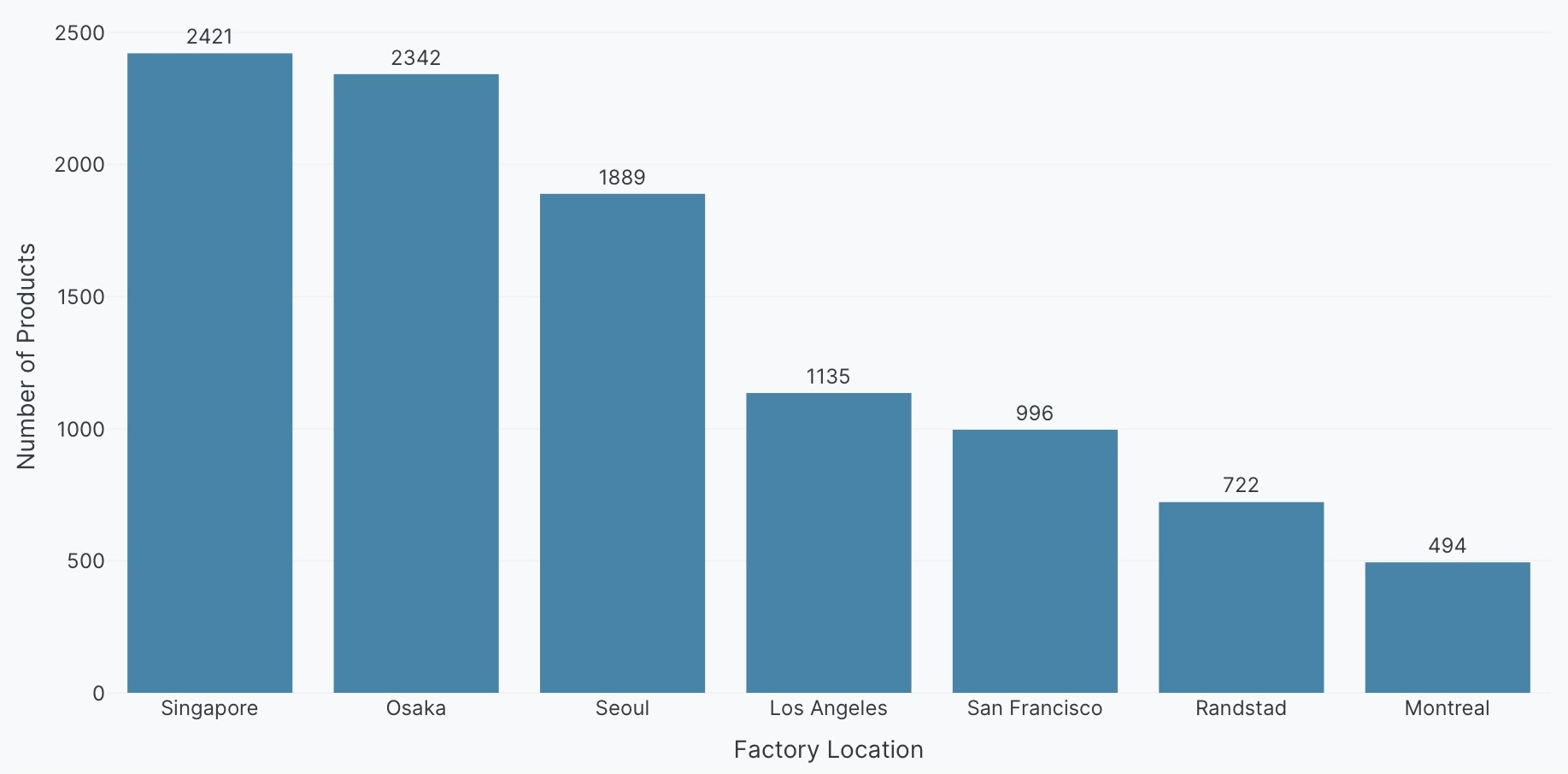
Pattern fills
Use patterns like dots, stripes, or crosses on bars to differentiate categories.
<Chart Title>
Chart:
- Type: bar
- X: <category_variable>
- Y: <numeric_variable>
- Color: <second_category>
Chart styles:
- Use grouped bars
- Use patterns
The following example uses this prompt structure with the factory_location and delivery_location variables from the built-in Plotly Studio dataset to add patterns to grouped bars:
Total Products by Factory and Delivery Location
Chart:
- Type: bar
- X: Factory location
- Y: Count of products
- Color: Delivery location
Data:
- Aggregation: count by Factory location and Delivery location
Chart styles:
- Use grouped bars
- Use patterns

Multiple bar charts within one chart
Create multiple bar charts within one chart to compare different categories or patterns across groups. These charts, often known as faceted charts or small multiples, let you display separate subplots for each category side-by-side.
<Chart Title>
Chart:
- Type: bar
- X: <category_variable>
- Y: <numeric_variable>
- Facet columns: <second_category>
The following example uses this prompt structure with the delivery_location and factory_location variables from the built-in Plotly Studio dataset to show separate subplots:
Total Products by Delivery Location and Factory
Chart:
- Type: bar
- X: Delivery location
- Y: Count of products
- Facet columns: Factory location
Data:
- Aggregation: count by Delivery location
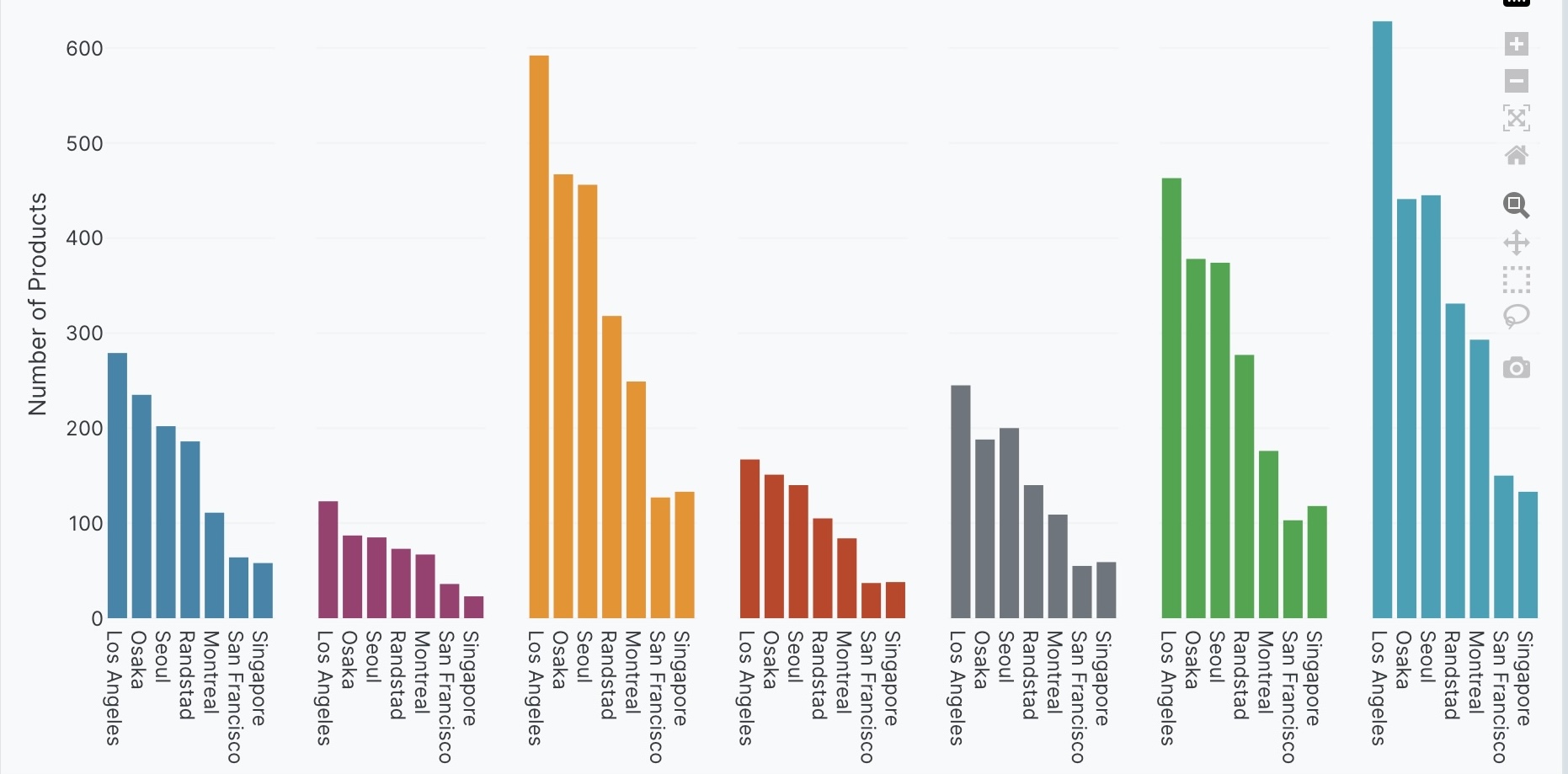
Bar charts with custom hover text
Add additional information on hover to provide more context about the data.
<Chart Title>
Chart:
- Type: bar
- X: <category_variable>
- Y: <numeric_variable>
Chart styles:
- Include <additional_info> on hover
The following example uses this prompt structure with the factory_location variable from the built-in Plotly Studio dataset to show custom hover text:
Total Products by Factory Location
Chart:
- Type: bar
- X: Factory location
- Y: Count of products
Data:
- Aggregation: count by Factory location
Chart styles:
- Include average_shipping_time on hover
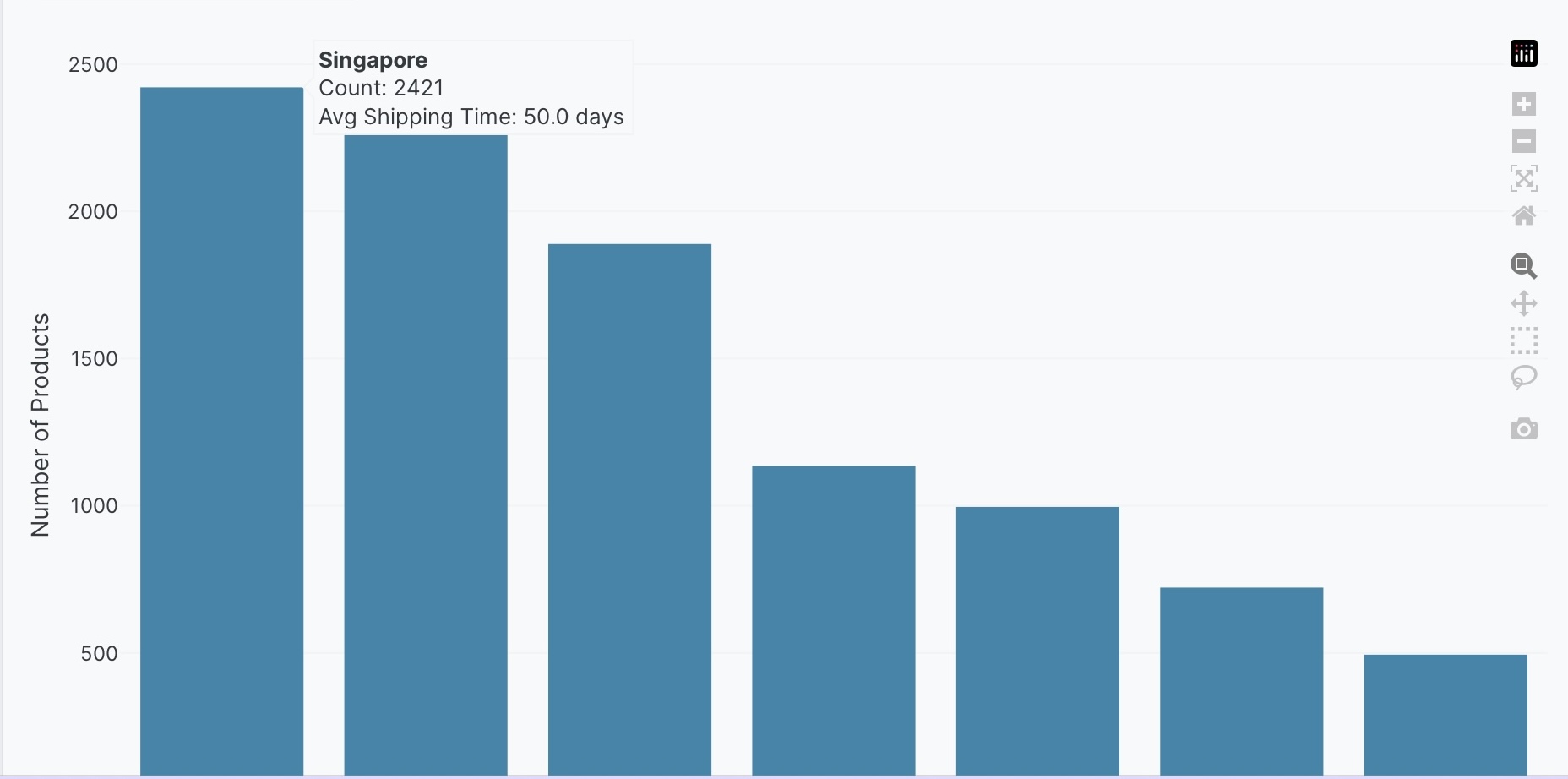
Rotated bar chart labels
Rotate x-axis labels to prevent overlapping when category names are long or numerous.
<Chart Title>
Chart:
- Type: bar
- X: <category_variable>
- Y: <numeric_variable>
Chart styles:
- Rotate x-axis labels <angle> degrees
The following example uses this prompt structure with the factory_location variable from the built-in Plotly Studio dataset to rotate labels:
Total Products by Factory Location
Chart:
- Type: bar
- X: Factory location
- Y: Count of products
Data:
- Aggregation: count by Factory location
Chart styles:
- Rotate x-axis labels 45 degrees
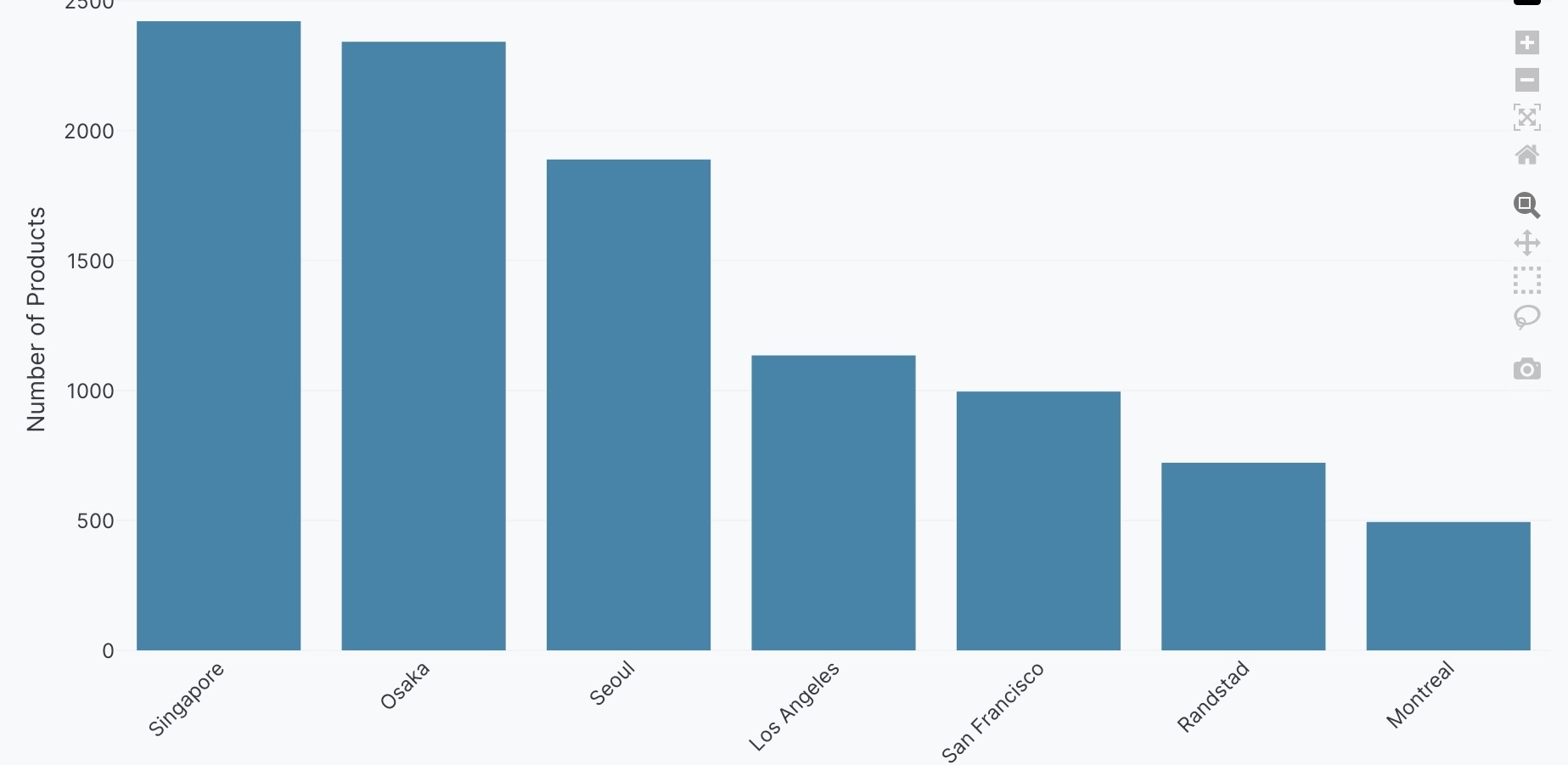
Customizing bar colors
Highlight a specific bar with a different color to draw attention to it.
<Chart Title>
Chart:
- Type: bar
- X: <category_variable>
- Y: <numeric_variable>
Chart styles:
- Highlight <specific_value> in <color>
The following example uses this prompt structure with the factory_location variable from the built-in Plotly Studio dataset to highlight a specific bar:
Total Products by Factory Location
Chart:
- Type: bar
- X: Factory location
- Y: Count of products
Data:
- Aggregation: count by Factory location
Chart styles:
- Highlight Montreal in red
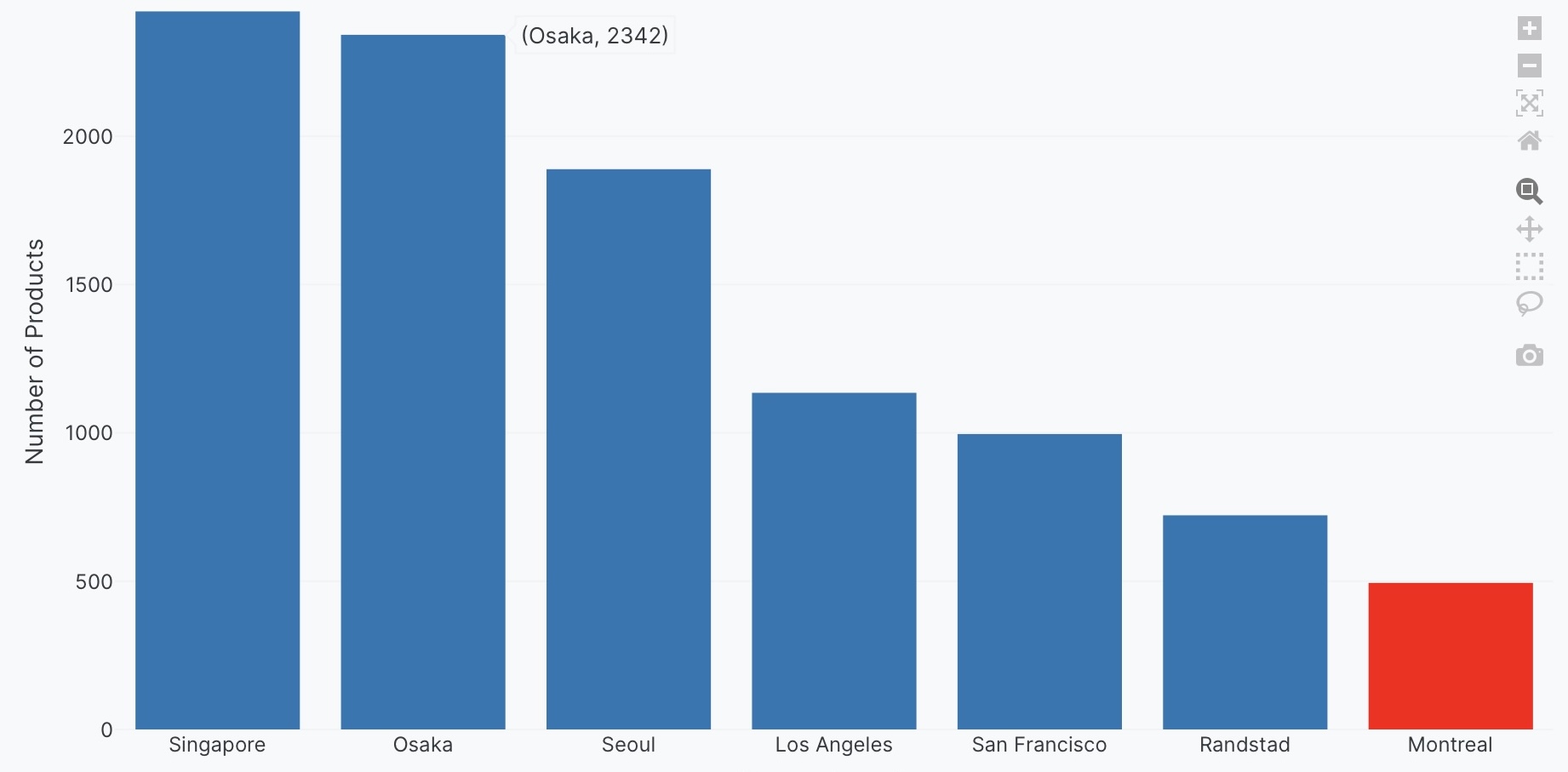
Rounded bars
Create bars with rounded corners for a softer, more modern look.
<Chart Title>
Chart:
- Type: bar
- X: <category_variable>
- Y: <numeric_variable>
Chart styles:
- Use rounded corners
The following example uses this prompt structure with the factory_location variable from the built-in Plotly Studio dataset to create bars with rounded corners:
Total Products by Factory Location
Chart:
- Type: bar
- X: Factory location
- Y: Count of products
Data:
- Aggregation: count by Factory location
Chart styles:
- Use rounded corners
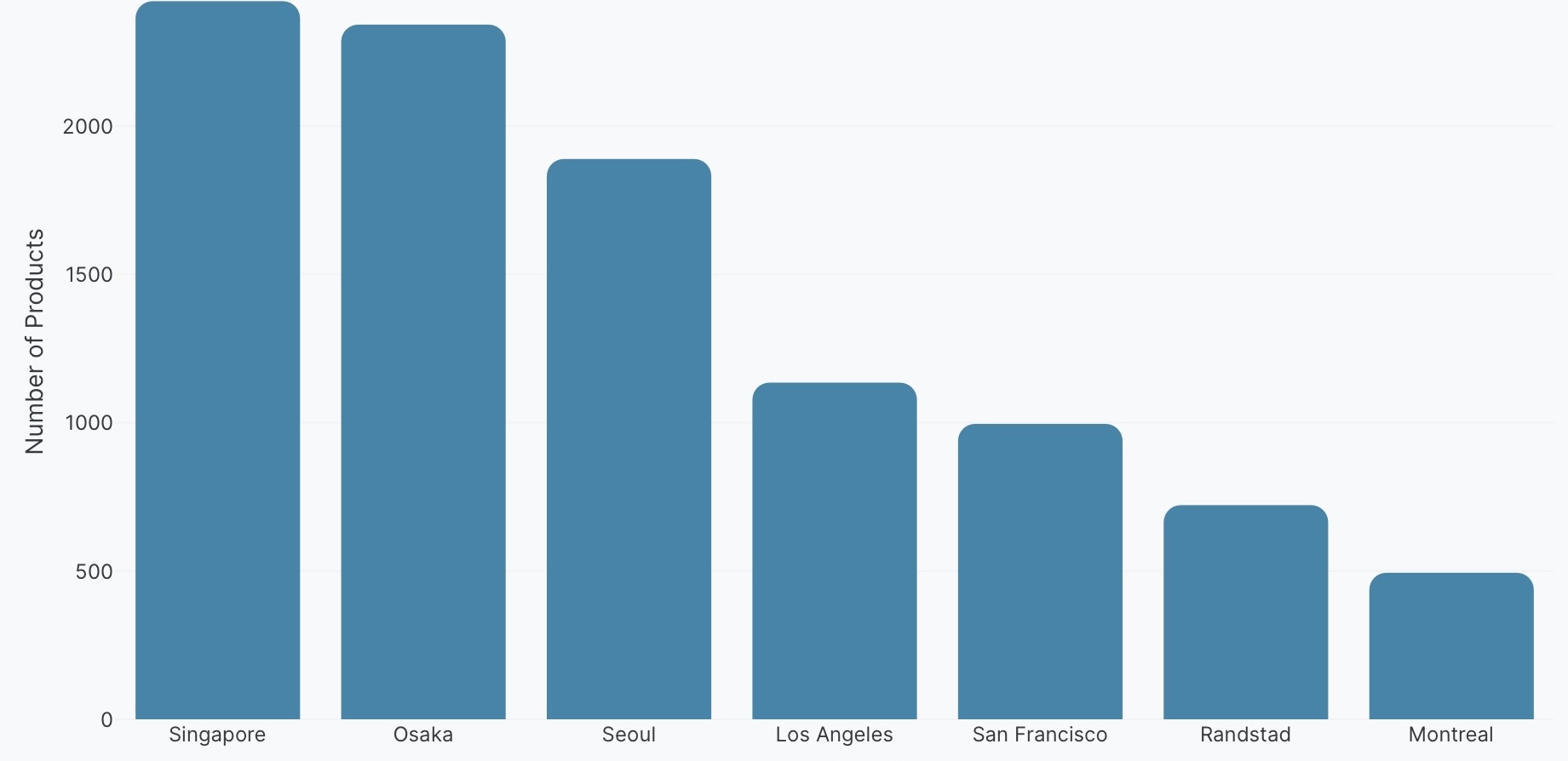
Interactive controls
Add dropdowns, sliders, and other controls to make your bar charts interactive. Controls let users filter and explore the data dynamically.
Total Products by Factory and Delivery Location
Chart:
- Type: bar
- X: Factory location
- Y: Count of products
- Color: Delivery location
Data:
- Aggregation: count by Factory location and Delivery location
Options:
- Dropdown to select delivery location (All, Montreal, Osaka, Seattle, Singapore) - Default All
- Checkbox to toggle between grouped and stacked bars - Default grouped
Prompt keywords reference
Use these keywords and phrases in your prompts to customize your bar chart.
Chart
Use a Chart: section in your prompt to define the basic structure of your bar chart, including the chart type and how variables map to visual properties.
Chart:
- Type: bar
- X: Factory location
- Y: Count of products
- Color: Delivery location
- Facet columns: Factory location
Here are some keyword suggestions to use in this section:
| Keyword/Phrase | Description | Example |
|---|---|---|
| Type | Specify the chart type as bar | Type: bar |
| X | The variable to show on the horizontal axis | X: Factory location |
| Y | The variable to show on the vertical axis | Y: Count of products |
| Color | Color bars by different groups or values | Color: Delivery location |
| Pattern shape | Map different pattern shapes to categories | Pattern shape: Defect |
| Facet rows | Create multiple plots stacked vertically by group | Facet rows: Factory location |
| Facet columns | Create multiple plots side-by-side by group | Facet columns: Factory location |
Data
Use a Data: section in your prompt to specify how to transform, filter, or aggregate your data before visualization.
Data:
- Aggregation: count by Factory location
- Computed field: Total value calculated as Price * Quantity
Here are some keyword suggestions to use in this section:
| Keyword/Phrase | Description | Example |
|---|---|---|
| Aggregation | Specify how to aggregate data | Aggregation: count by Factory location |
| Computed field | Create new calculated fields from existing data | Computed field: Total value calculated as Price * Quantity |
| Filter | Filter data to show only specific records | Filter to show only defect = true |
Options
Use an Options: section in your prompt to add interactive controls that allow users to dynamically filter, transform, and visualize data without regenerating the chart.
Options:
- Dropdown to select delivery location (All, Montreal, Osaka) - Default All
- Checkbox to toggle between grouped and stacked bars - Default grouped
Here are some keyword suggestions to use with this section. See Chart Controls for a complete list of control types and additional examples.
| Keyword/Phrase | Description | Example |
|---|---|---|
| Dropdown | Add a dropdown menu to filter by categories | Dropdown to select delivery location (All, Montreal, Osaka) - Default All |
| Checkbox | Add a checkbox to toggle options | Checkbox to toggle between grouped and stacked bars - Default grouped |
Chart styles
Use a Chart styles: section in your prompt to control the visual appearance and formatting of your bar chart.
Chart styles:
- Use custom colors: #FF5733, #33FF57
- Make the chart horizontal
- Use grouped bars
- Show values on bars
Here are some keyword suggestions to use in this section:
| Keyword/Phrase | Description | Example |
|---|---|---|
| Custom colors | Specify exact colors for bars | Use custom colors: #FF5733, #33FF57 |
| Highlight | Highlight a specific bar with a different color | Highlight Montreal in red |
| Horizontal orientation | Flip bars to horizontal orientation | Make the chart horizontal |
| Grouped bars | Create bars side-by-side for comparison | Use grouped bars |
| Stacked bars | Stack bars on top of each other | Use stacked bars |
| Text on bars | Display values on the bars | Show values on bars |
| Bar width | Set the width of the bars | Set bar width to 0.8 |
| Rounded corners | Create bars with rounded corners | Use rounded corners |
| Patterns | Use patterns like dots, stripes, or crosses on bars | Use dotted pattern for Osaka |
| Hover text | What to show when hovering over bars | Show Factory location on hover |
| Axis labels | Customize the text shown on the axes | Label x-axis as "Factory"Label y-axis as "Product Count" |
| Background color | Set the background color of the plot | Set background color to lightblue |
| Grid lines | Show or hide grid lines on the plot | Hide grid lines |
| Color scale | Specify color scale for continuous color mapping. See built-in color scales | Use Viridis color scale |
| Rotate axis labels | Rotate x-axis labels to prevent overlapping | Rotate x-axis labels 45 degrees |
| Sort | Sort bars in ascending or descending order | Sort bars descending |
| Opacity | How see-through the bars are (0=invisible, 1=solid) | Set opacity to 0.5 |
| Axis range | Set minimum and maximum values for axes | Set y-axis range from 0 to 3000 |
| Legend | Control legend display and position | Show legend at top right |